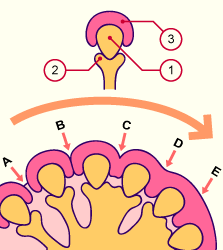At birth the kidneys have a multilobular appearance, due to the development of the ureter anlage in the metanephric blastema. Normally, towards the end of the fetal period, the lobes are considerably smoothed, but they still exist until after birth.
Completion of the smoothing follows during childhood by the increase in volume of the connective tissue and the increase in size of the nephrons without any change in their number. With only few exceptions, adult kidneys no longer exhibit any lobulation.
Since the renal architecture is finalized between the 5th and 15th weeks of intrauterine development; organogenesis of the kidneys lasts well beyond the embryonic phase until far into the fetal period.
|
|
Fig. 13 - Development of the
smooth kidney surface |
|
Legend |
|

1
2
3
|
Renal medulla
Calix minor
Renal cortex |
|
|
|
Fig. 13
In humans renal lobulation is easily seen only in the embryonic and fetal periods, but can extend into childhood.
At birth, however, it is strongly attenuated.
In adults, the cortical zones of the individual lobes, "A to E", fuse and the smoothing of their depressions leads to a smooth and uniform renal surface structure.
|